An Inter-Ridge Navigation Path Extraction Method Based on Res2net50 Segmentation Model
Abstract
1. Introduction
- Two modules are introduced by this method: the Atrous Spatial Pyramid Pooling (ASPP) module and the SE attention mechanism. The SE attention mechanism enhances focus on ridge feature information while minimizing the impact of background variables. To obtain the multiscale information of ridge rows, ASPP builds convolution kernels of various receptive fields using various void rates. As a result, ridge rows in the field environment can be predicted more precisely;
- In order to keep the gradient present throughout training, an jump connection structure is used in this research. Feature keeps using ASPP to extract high-dimensional feature data. Finally, feature fusion of and x2 can greatly enhance crop ridge segmentation accuracy;
- The validity and robustness of the model prediction are examined empirically in this work, using the ridge row data sets collected in the field under various lighting conditions. The experimental findings demonstrate that the enhanced Res2net50 segmentation model can increase the efficiency and precision of acquiring navigational data and offer technical assistance for future studies on rural navigation.
2. Materials and Methods
2.1. Experimental Platform and Equipment
2.2. Semantic Segmentation of Ridge Road Based on Neural Network
2.2.1. Data Acquisition
2.2.2. Data Processing
2.2.3. The Optimized Res2net50 Network Segmentation Model
2.2.4. Loss Function
2.2.5. Navigation Line Extraction
3. Experiment and Result Analysis
3.1. Prediction Network Model
3.1.1. Index for Evaluating Semantic Segmentation Models
3.1.2. Model Training
3.1.3. Model Training Process
3.2. Analysis of Experimental Results
3.2.1. The Model’s Response to Parameter Optimization
- The influence of learning rate on model performance
- 2.
- The effect of batch size on model performance
3.2.2. Predict the Outcomes of Experiments
- An experiment on ablation
- 2.
- Comparison of detection performance of different models
3.2.3. Navigation Path Accuracy Evaluation
3.2.4. Pixel Error Comparison
4. Conclusions
- The experimental results show that the improved Res2Net50 model in this paper has significantly improved MIOU and F- measure values after the introduction of an SE attention mechanism module and ASPP feature pyramid module compared with the original Res2net50, indicating that the optimized model has stronger feature extraction ability and higher extraction accuracy. Compared with other models, the optimized model converges quickly and with small loss, and can identify the monopoly row features well.
- Under different lighting conditions, the average distance error of this method is 0.76 cm, the normal driving speed of the field wheeled chassis is between 0 and 1.5 m/s, and the average processing time of a single image is 0.164 s. With further improvements in the hardware configuration, this study can provide an effective reference for visual navigation tasks.
- Given that the training set in this study contains insufficient corresponding scenarios, the usage environment for this method may be restricted. As a result, more data will be collected from different field environments in future work, in order to expand the data set, improve the practicability of the model, and promote the use of semantic segmentation in intelligent visual navigation.
Author Contributions
Funding
Institutional Review Board Statement
Data Availability Statement
Conflicts of Interest
References
- Zhang, M.; Ji, H.; Li, S.; Cao, Y.; Xu, H.; Zhang, Z. Research Progress of Agricultural Machinery Navigation Technology. Trans. Chin. Soc. Agric. Mach. 2020, 51, 1–18. [Google Scholar] [CrossRef]
- Gao, G.; Li, M. Navigation path recognition of greenhouse mobile robot based on K-means algorithm. Trans. Chin. Soc. Agric. Eng. 2014, 30, 25–33. [Google Scholar] [CrossRef]
- Zhang, X.; Chen, B.; Li, J.; Liang, X.; Yao, Q.; Mu, S.; Yao, W. Vision navigation path detection of jujube harvester. Agric. Inf. Electr. Technol. 2020, 36, 133–140. [Google Scholar] [CrossRef]
- Bao, W.; Sun, Q.; Hu, G.; Huang, L.; Liang, D.; Zhao, J. Image recognition of wheat scab in field based on multi-channel convolutional neural network. Trans. Chin. Soc. Agric. Eng. 2020, 36, 174–181. [Google Scholar] [CrossRef]
- Wang, Y.; Liu, B.; Xiong, L.; Xiong, L.; Wang, Z.; Yang, C. Research on orchard road navigation line generation algorithm based on deep learning. J. Hunan Agric. Univ. (Nat. Sci.) 2019, 45, 674–678. [Google Scholar] [CrossRef]
- Chen, J.; Jiang, H. Ridge multi-scale segmentation algorithm in visual navigation. Laser Optoelectron. Prog. 2020, 57, 161–168. [Google Scholar] [CrossRef]
- Han, Z.; Li, J.; Yuan, Y.; Fang, X.; Zhao, B.; Zhu, L. Orchard visual navigation path recognition method based on U-Net network. Trans. Chin. Soc. Agric. Mach. 2021, 52, 30–39. [Google Scholar] [CrossRef]
- Rao, X.; Zhu, Y.; Zhu, Y.; Zhang, Y.; Yang, H.; Zhang, X.; Lin, Y.; Geng, J.; Ying, Y. Navigation path recognition between crop ridges based on semantic segmentation. Trans. Chin. Soc. Agric. Eng. 2021, 37, 179–186. [Google Scholar] [CrossRef]
- Huang, L.; Li, S.; Tan, Y.; Wang, S. Research on path navigation based on improved convolutional neural network algorithm. J. Chin. Agric. Mech. 2022, 43, 146–152, 159. [Google Scholar] [CrossRef]
- Li, J.; Yin, J.; Deng, L. A robot vision navigation method using deep learning in edge computing environment. EURASIP J. Adv. Signal Process. 2021, 2021, 22. [Google Scholar] [CrossRef]
- Cao, M.; Tang, F.; Ji, P.; Ma, F. Improved Real-Time Semantic Segmentation Network Model for Crop Vision Navigation Line Detection. Front. Plant Sci. 2022, 13, 898131. [Google Scholar] [CrossRef] [PubMed]
- Wang, D.; Wang, J. Crop disease classification based on transfer learning and residual network. Trans. Chin. Soc. Agric. Eng. 2021, 37, 199–207. [Google Scholar]
- Jia, Z.; Zhang, Y.; Wang, H.; Liang, D. Tomato disease period recognition method based on Res2Net and bilinear attention. Trans. Chin. Soc. Agric. Mach. 2022, 53, 259–266. [Google Scholar] [CrossRef]
- Wang, C.; Zhou, J.; Wu, H.; Teng, G.; Zhao, C.; Li, J. Improved Multi-scale ResNet for vegetable leaf disease identification. Trans. Chin. Soc. Agric. Eng. 2020, 36, 209–217. [Google Scholar] [CrossRef]
- Gao, S.; Cheng, M.; Zhao, K.; Zhang, X.; Yang, M.; Torr, P. Res2net: A new multi-scale backbone architecture. IEEE Trans. Pattern Anal. Mach. Intell. 2019, 43, 652–662. [Google Scholar] [CrossRef]
- Xu, Q.; Liang, Y.; Wang, D.; Luo, B. Hyperspectral image classification based on SE-Res2Net and multi-scale spatial-spectral fusion attention mechanism. J. Comput.-Aided Des. Comput. Graph. 2021, 33, 1726–1734. [Google Scholar] [CrossRef]
- Sun, Y.; Zhang, W.; Wang, R.; Li, C.; Zhang, Q. Pedestrian re-identification method based on channel attention mechanism. J. Beijing Univ. Aeronaut. Astronaut. 2022, 48, 881–889. [Google Scholar] [CrossRef]
- Yang, M.; Yu, K.; Zhang, C.; Zhang, W.; Yang, K. Dense ASPP for semantic segmentation in street scenes. In Proceedings of the IEEE Conference on Computer Vision and Pattern Recognition, Salt Lake City, UT, USA, 18–23 June 2018; pp. 3684–3692. [Google Scholar] [CrossRef]
- Shen, Y.; Yuan, Y.; Peng, J.; Chen, X.; Yang, Q. River extraction from remote sensing images in cold and arid regions based on deep learning. Trans. Chin. Soc. Agric. Mach. 2020, 51, 192–201. [Google Scholar] [CrossRef]
- Ahmad, P.; Jin, H.; Qamar, S.; Zhang, R.; Saeed, A. Densely connected residual networks using ASPP for brain tumor segmentation. Multimed. Tools Appl. 2021, 80, 27069–27094. [Google Scholar] [CrossRef]
- Li, Z.; Xu, J.; Zheng, L.; Tie, J.; Yu, S. A small sample identification method for tea diseases based on improved DenseNet. Trans. Chin. Soc. Agric. Eng. 2022, 38, 182–190. [Google Scholar] [CrossRef]
- Jiang, W.; Peng, J.; Ye, G. Research on deep learning adaptive learning rate algorithm. J. Huazhong Univ. Sci. Technol. (Nat. Sci. Ed.) 2019, 47, 79–83. [Google Scholar] [CrossRef]
- Li, M.; Lai, G.; Chang, Y.; Feng, Z. Performance analysis of different optimizers in deep learning algorithms. Inf. Technol. Informatiz. 2022, 47, 206–209. [Google Scholar] [CrossRef]
- Ren, J.J.; Wang, N. Research on loss function in artificial neural network. J. Gansu Norm. Coll. 2018, 23, 61–63. [Google Scholar] [CrossRef]
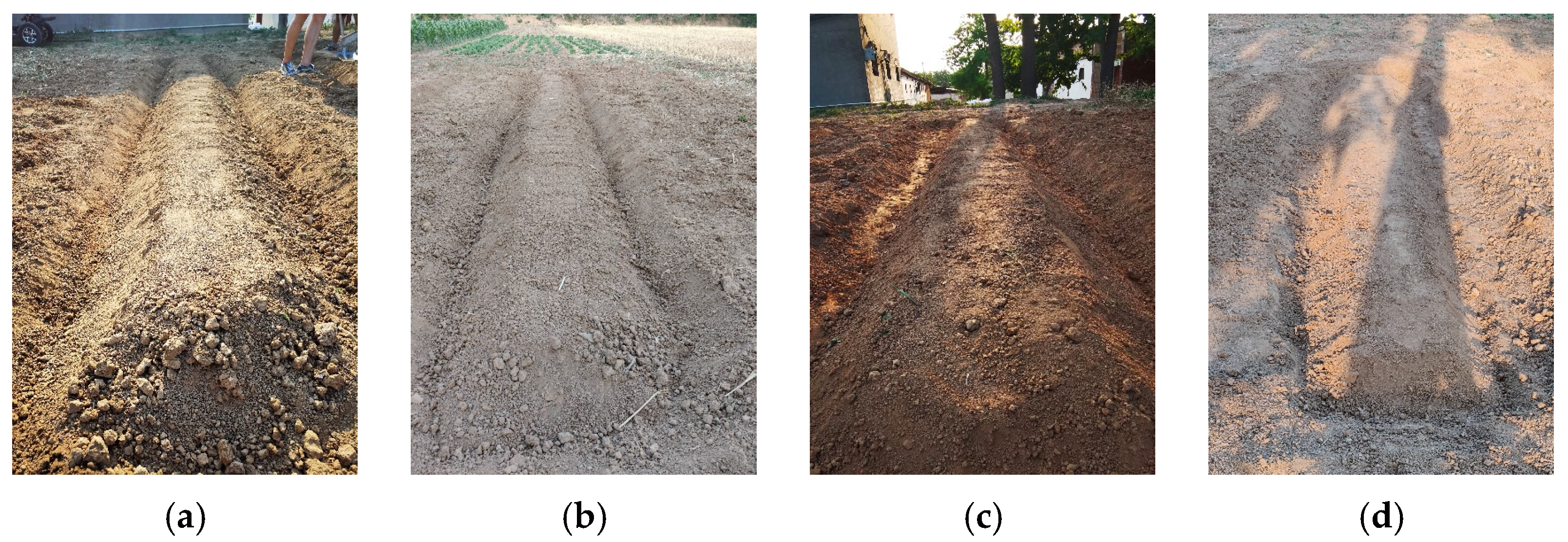
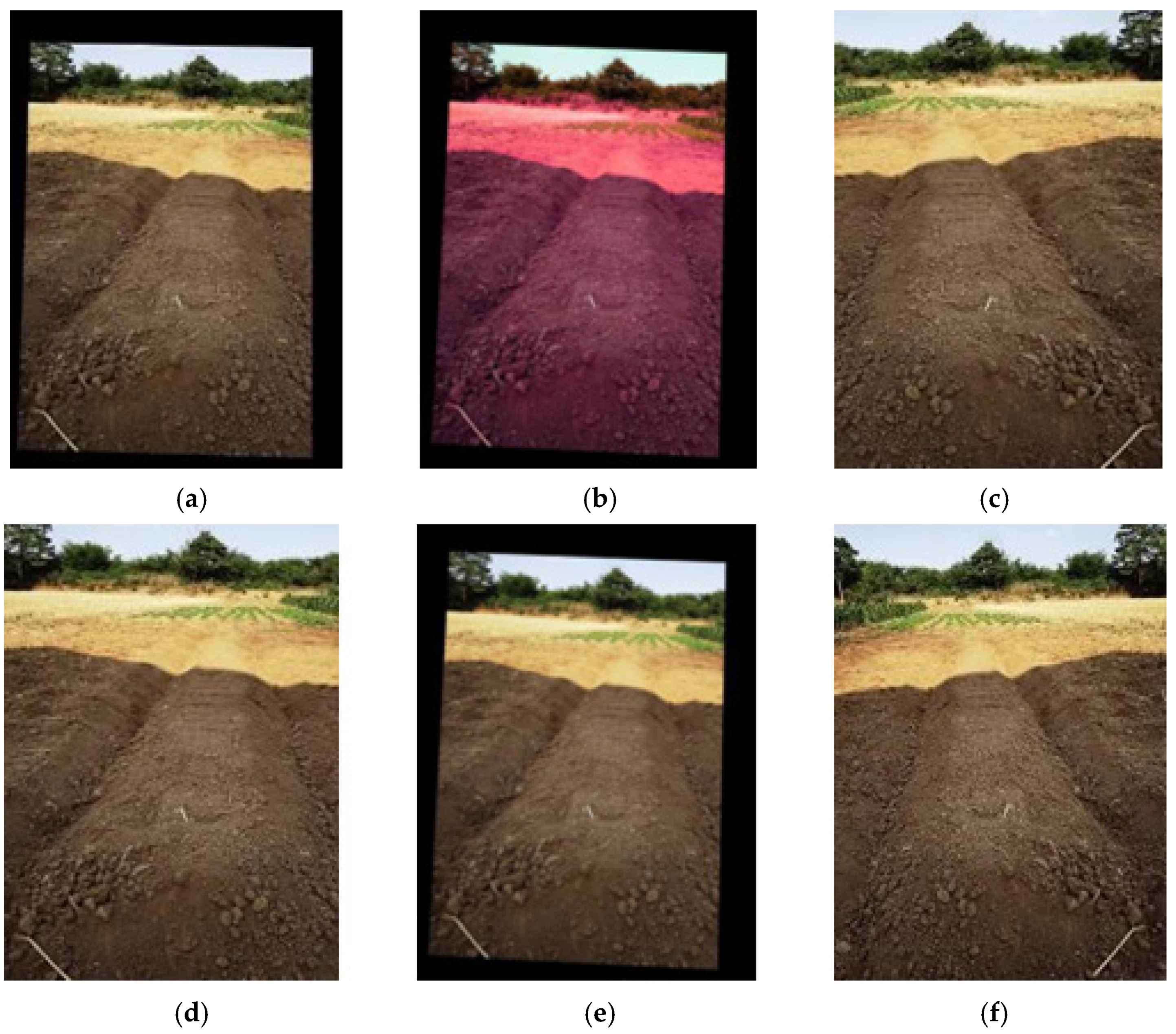
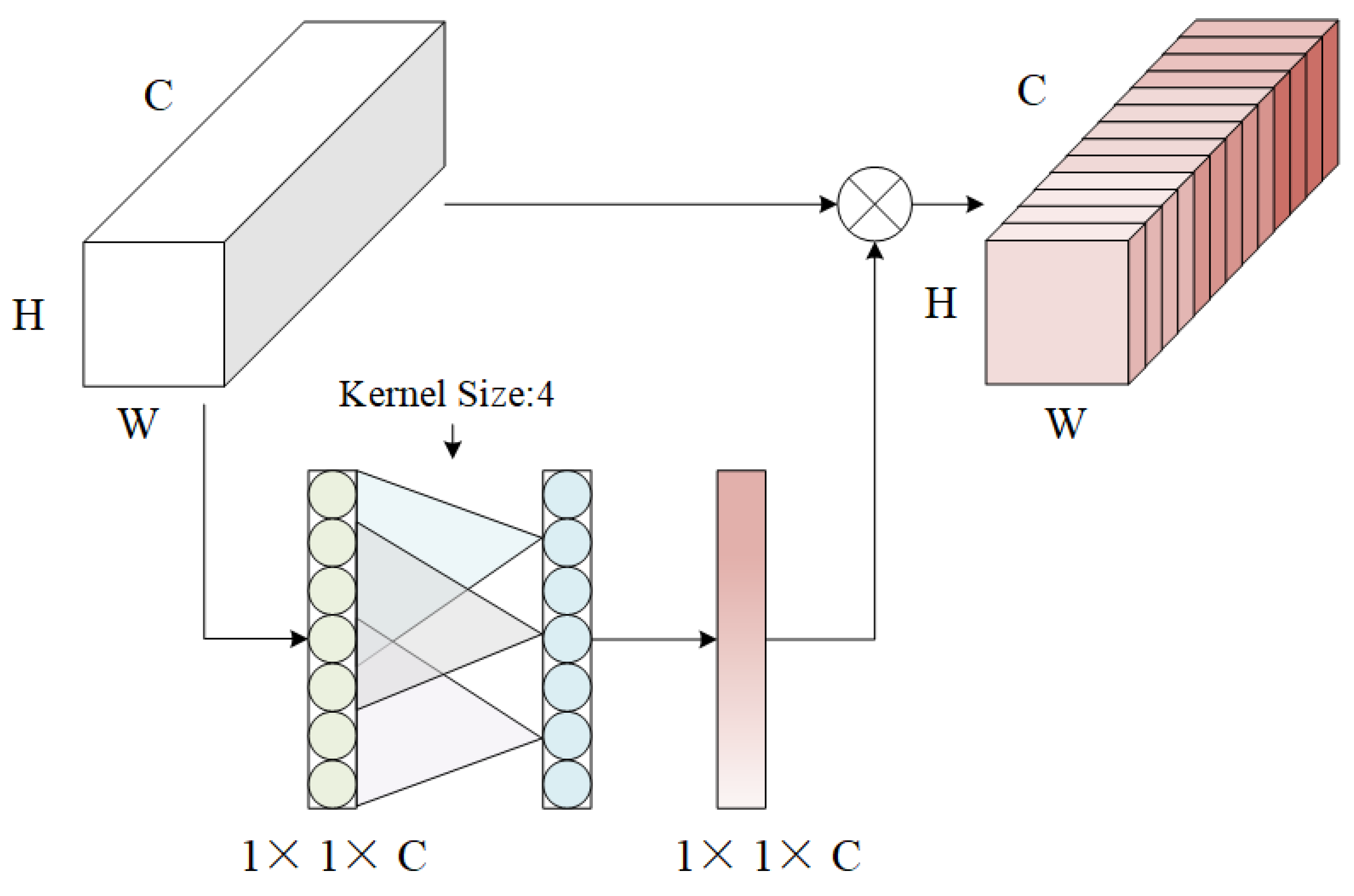

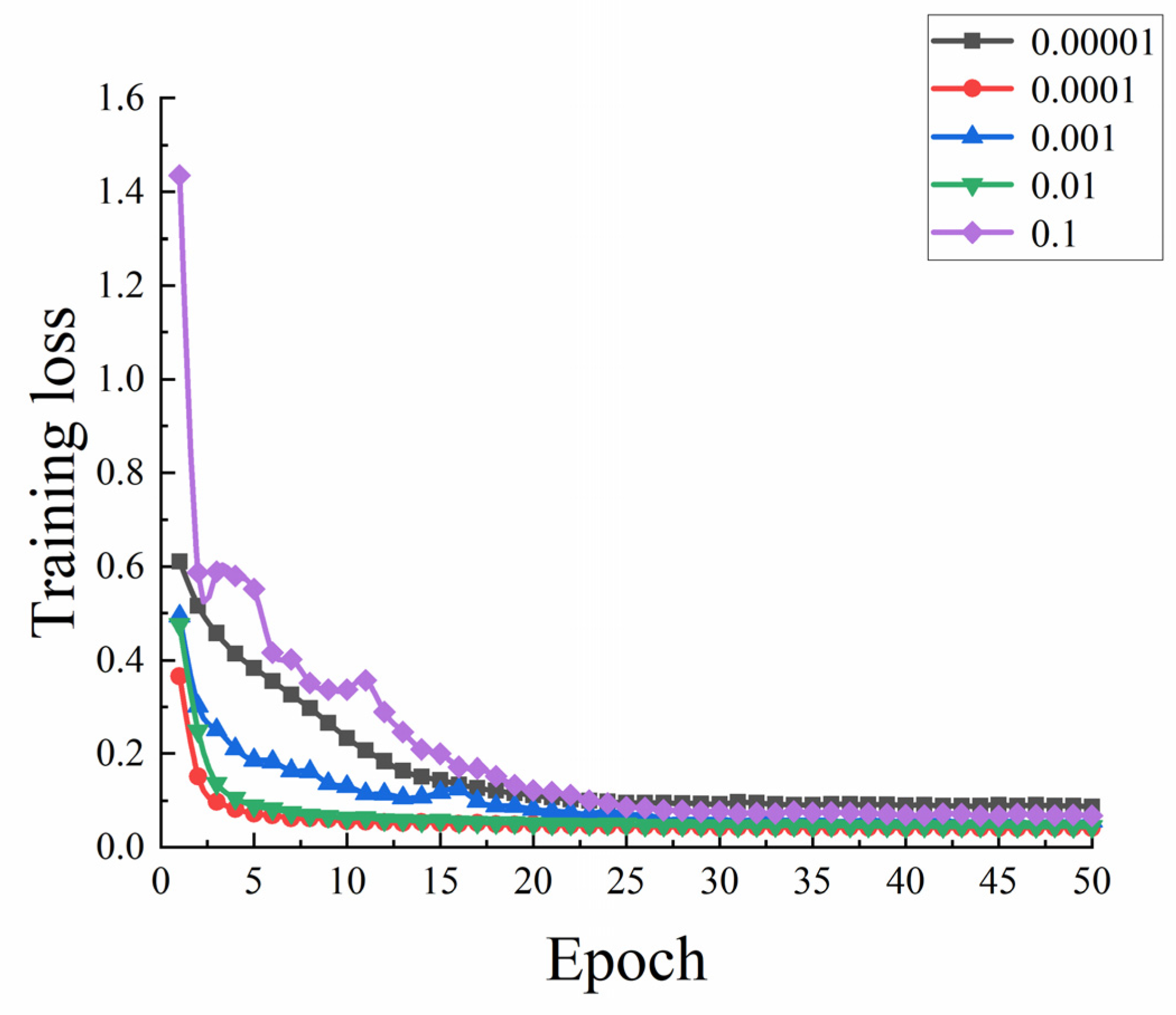
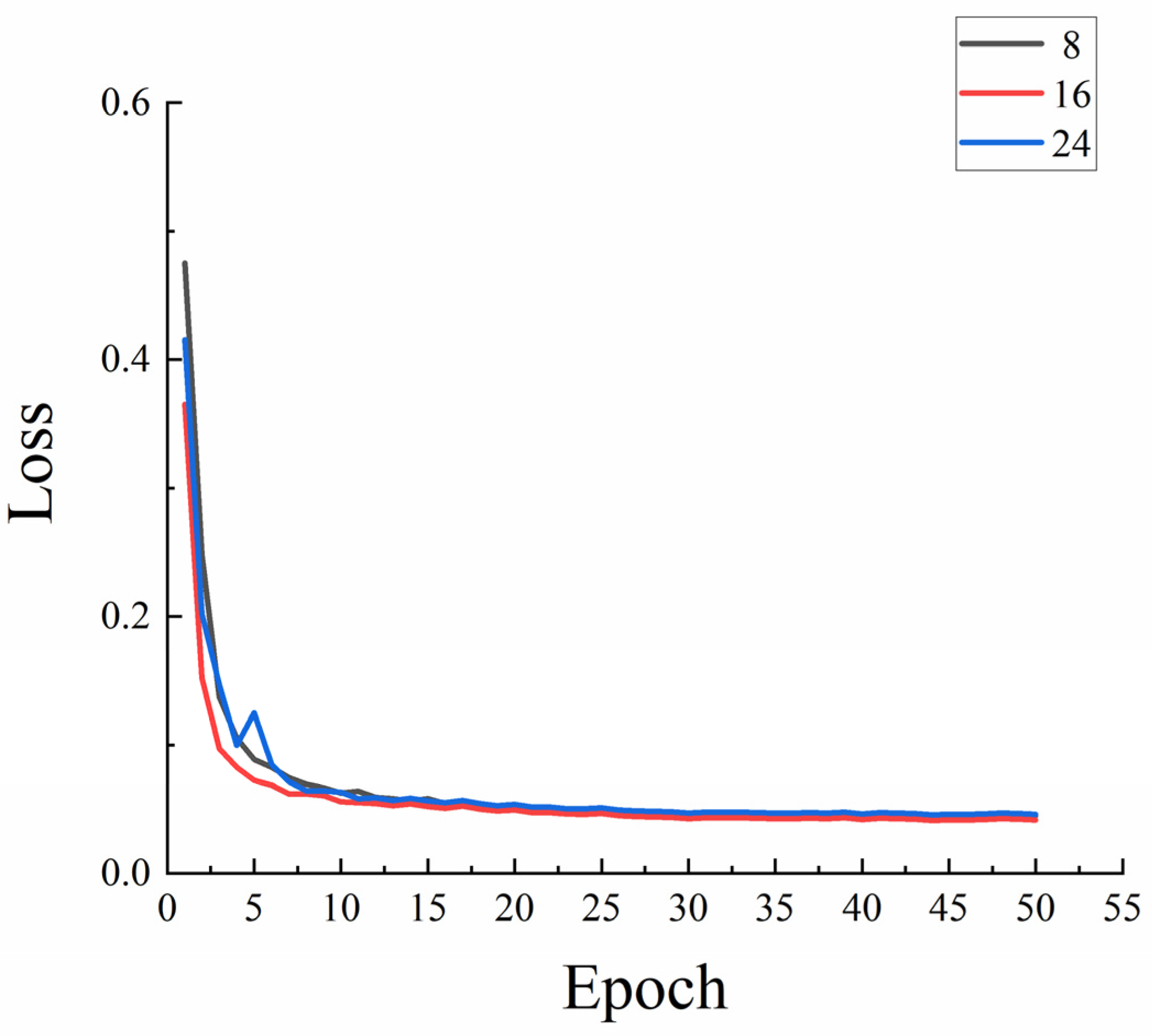
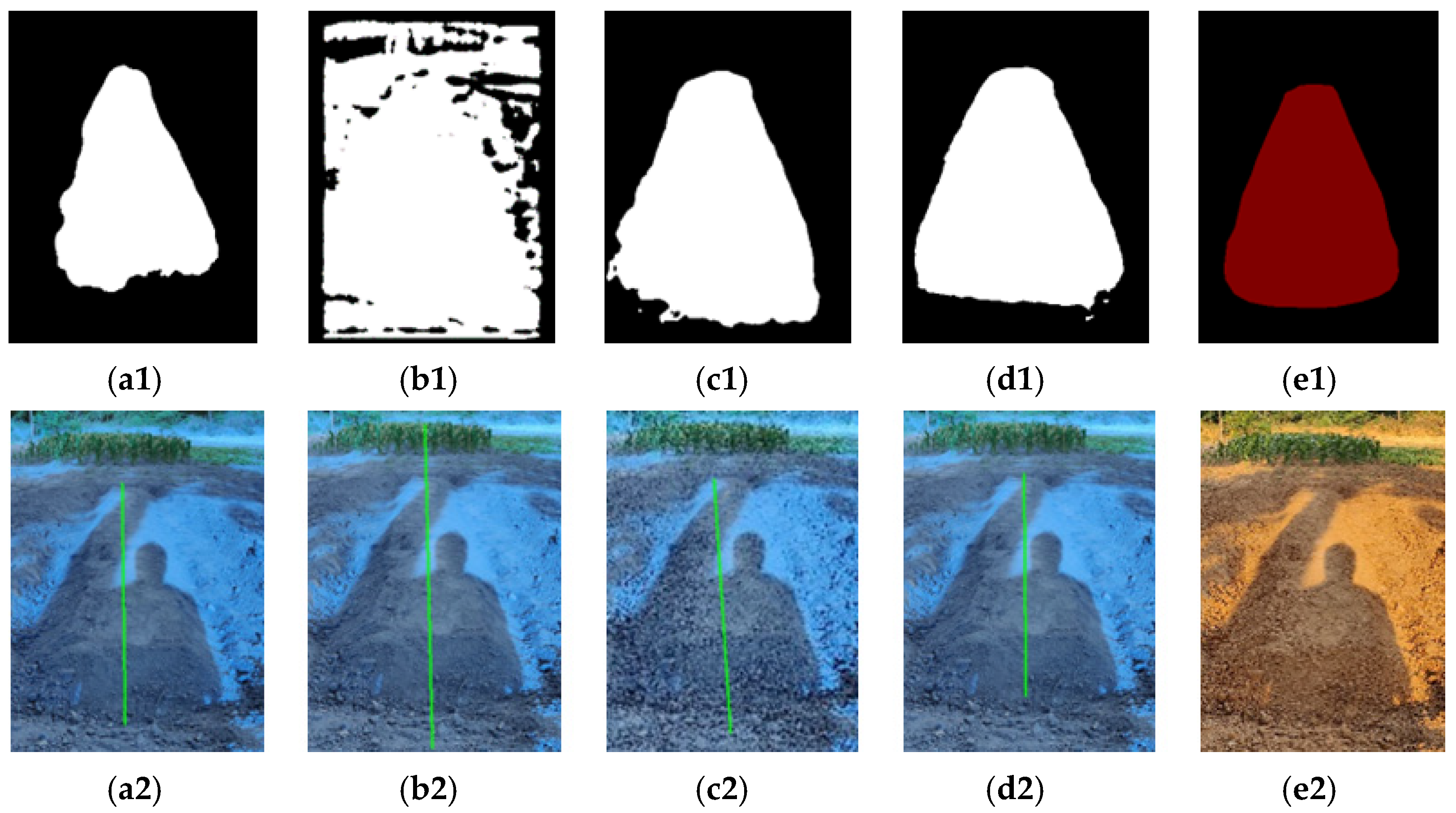
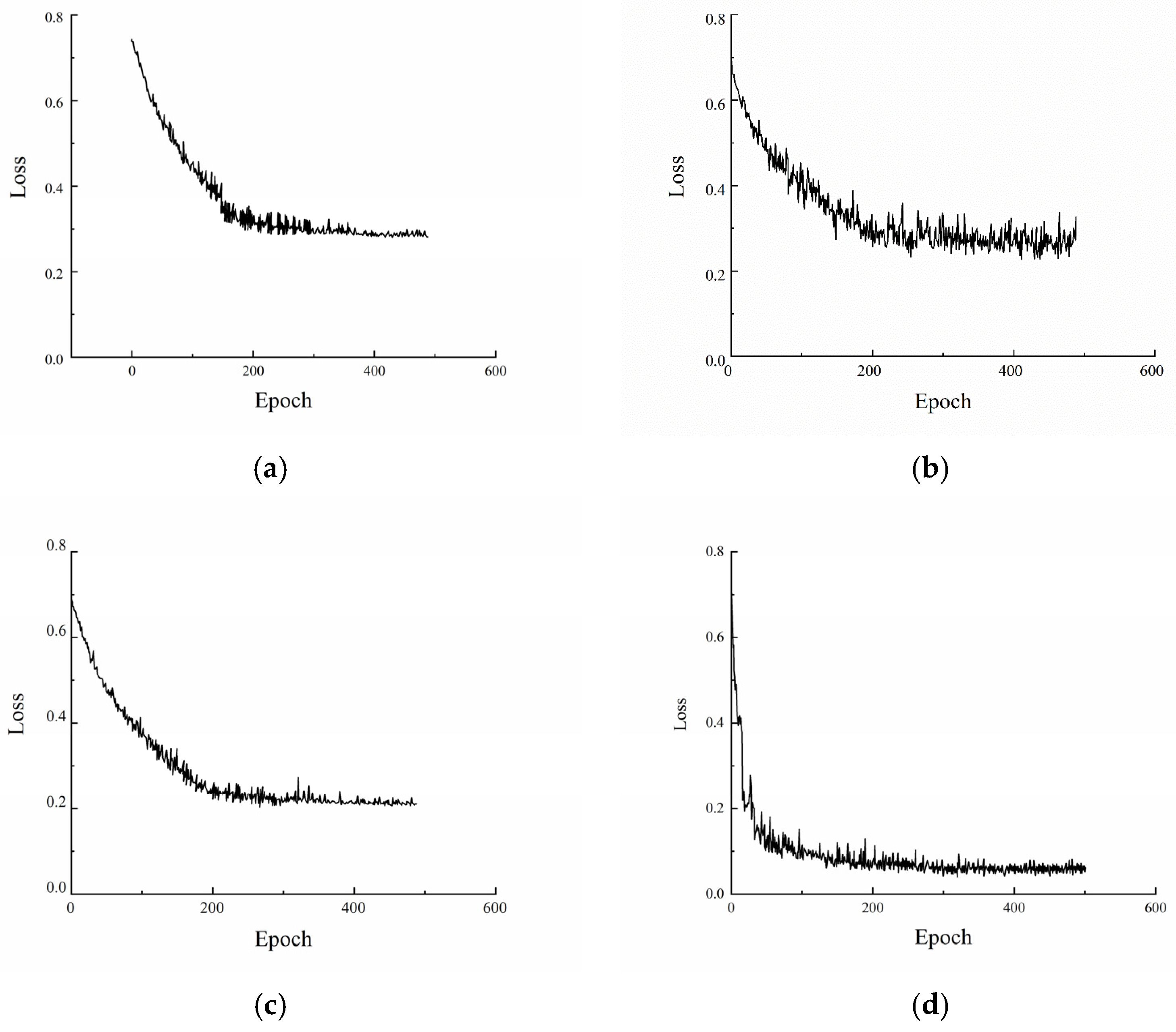
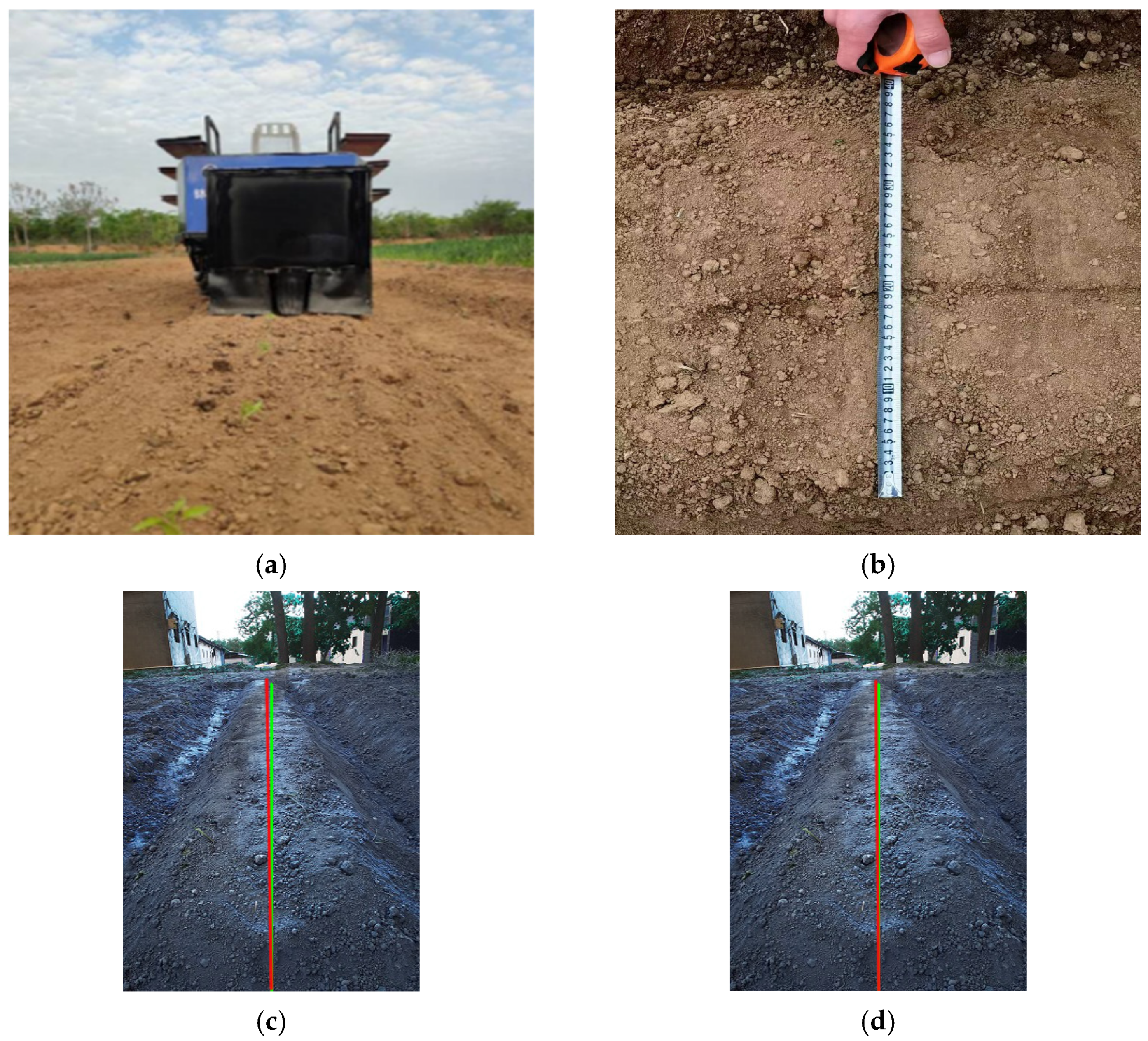
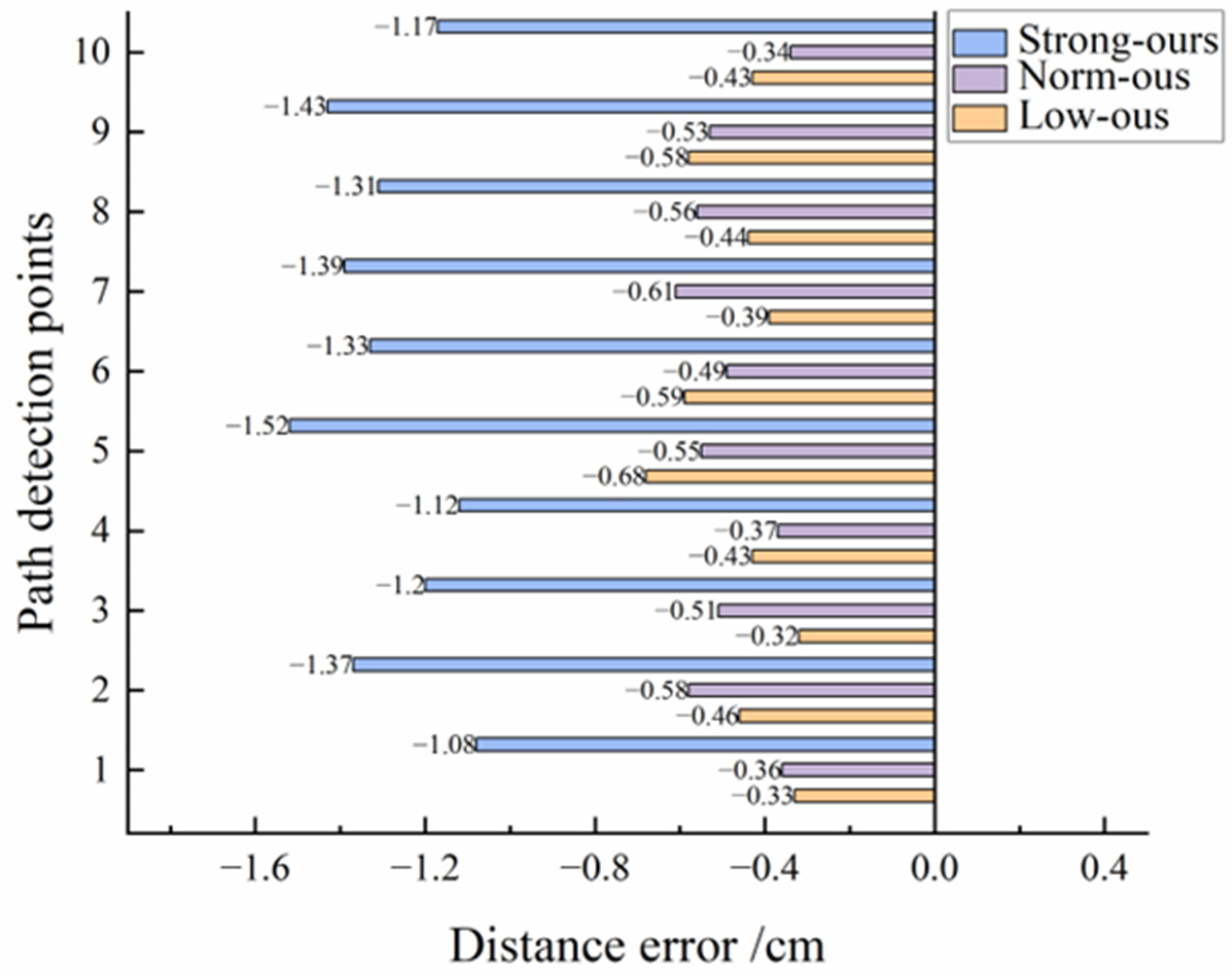

| Model | MIOU | F-Measure |
|---|---|---|
| Res2net50 + SE+ASPP | 0.905 | 0.917 |
| Res2net50 + ASPP | 0.838 | 0.879 |
| Res2net50 + SE | 0.834 | 0.862 |
| Res2net50 | 0.748 | 0.856 |
| Models | MIOU | F-Measure | Precision | Recall | Training Time | Forecast Time |
|---|---|---|---|---|---|---|
| Unet | 0.732 | 0.775 | 0.736 | 0.993 | 6 h | 0.565 s |
| VGG | 0.475 | 0.531 | 0.476 | 0.993 | 7 h | 0.499 s |
| Res2net50 | 0.748 | 0.856 | 0.811 | 0.908 | 8 h | 0.387 s |
| Our model | 0.905 | 0.917 | 0.883 | 0.955 | 7.5 h | 0.164 s |
| Experimental Group | Experimental Group 1 | Experimental Group 2 |
|---|---|---|
| 1 | 1.452° | 1.421° |
| 2 | 1.413° | 1.385° |
| 3 | 1.356° | 1.342° |
| 4 | 1.395° | 1.382° |
| 5 | 1.411° | 1.399° |
| Average yaw angle | 1.405° | 1.385° |
| Path Detection Points | Pixel Error/Pixel | Distance Error/cm | ||||
|---|---|---|---|---|---|---|
| Low Light | Ordinary Light | Strong Light | Low Light | Ordinary Light | Strong Light | |
| 1 | 8.6 | 7.3 | 5.7 | 0.69 | 0.63 | 0.72 |
| 2 | 7.2 | 8.2 | 6.8 | 0.59 | 0.69 | 0.79 |
| 3 | 9.6 | 8.5 | 5.3 | 0.76 | 0.71 | 0.69 |
| 4 | 9.8 | 7.9 | 6.1 | 0.77 | 0.67 | 0.75 |
| 5 | 9.9 | 8.6 | 9.3 | 0.78 | 0.72 | 0.97 |
| 6 | 10.2 | 9.6 | 7.5 | 0.80 | 0.79 | 0.84 |
| 7 | 7.7 | 8.4 | 6.6 | 0.63 | 0.71 | 0.78 |
| 8 | 8.4 | 7.9 | 6.1 | 0.68 | 0.67 | 0.75 |
| 9 | 11.1 | 8.1 | 8.3 | 0.86 | 0.78 | 0.90 |
| 10 | 12.5 | 9.8 | 7.3 | 0.96 | 0.80 | 0.83 |
| Average | 9.50 | 8.43 | 6.90 | 0.75 | 0.71 | 0.80 |
| Variance | 1.59 | 0.77 | 1.23 | 0.11 | 0.05 | 0.09 |
| Path Detection Points | Pixel Error/Pixel | Distance Error/cm | ||||
|---|---|---|---|---|---|---|
| Low Light | Ordinary Light | Strong Light | Low Light | Ordinary Light | Strong Light | |
| 1 | 7.8 | 6.9 | 10.2 | 1.02 | 0.99 | 1.20 |
| 2 | 8.5 | 12.5 | 12.3 | 1.05 | 1.27 | 1.30 |
| 3 | 9.1 | 11.5 | 9.6 | 1.08 | 1.22 | 1.17 |
| 4 | 11.5 | 7.9 | 8.3 | 1.20 | 1.04 | 1.10 |
| 5 | 16.7 | 12.5 | 6.8 | 1.46 | 1.27 | 1.03 |
| 6 | 15.3 | 12.7 | 13.6 | 1.39 | 1.28 | 1.37 |
| 7 | 7.8 | 13.4 | 6.6 | 1.02 | 1.32 | 1.02 |
| 8 | 9.8 | 11.7 | 10.3 | 1.12 | 1.23 | 1.20 |
| 9 | 16.2 | 11.2 | 16.4 | 1.44 | 1.21 | 1.51 |
| 10 | 15.3 | 9.8 | 9.6 | 1.39 | 1.14 | 1.17 |
| Average | 11.8 | 11.01 | 10.37 | 1.22 | 1.20 | 1.21 |
| Variance | 3.68 | 2.15 | 3.04 | 0.18 | 0.11 | 0.15 |
Disclaimer/Publisher’s Note: The statements, opinions and data contained in all publications are solely those of the individual author(s) and contributor(s) and not of MDPI and/or the editor(s). MDPI and/or the editor(s) disclaim responsibility for any injury to people or property resulting from any ideas, methods, instructions or products referred to in the content. |
© 2023 by the authors. Licensee MDPI, Basel, Switzerland. This article is an open access article distributed under the terms and conditions of the Creative Commons Attribution (CC BY) license (https://creativecommons.org/licenses/by/4.0/).
Share and Cite
Jin, X.; Lin, C.; Ji, J.; Li, W.; Zhang, B.; Suo, H. An Inter-Ridge Navigation Path Extraction Method Based on Res2net50 Segmentation Model. Agriculture 2023, 13, 881. https://doi.org/10.3390/agriculture13040881
Jin X, Lin C, Ji J, Li W, Zhang B, Suo H. An Inter-Ridge Navigation Path Extraction Method Based on Res2net50 Segmentation Model. Agriculture. 2023; 13(4):881. https://doi.org/10.3390/agriculture13040881
Chicago/Turabian StyleJin, Xin, Cheng Lin, Jiangtao Ji, Wenhao Li, Bo Zhang, and Hongbin Suo. 2023. "An Inter-Ridge Navigation Path Extraction Method Based on Res2net50 Segmentation Model" Agriculture 13, no. 4: 881. https://doi.org/10.3390/agriculture13040881
APA StyleJin, X., Lin, C., Ji, J., Li, W., Zhang, B., & Suo, H. (2023). An Inter-Ridge Navigation Path Extraction Method Based on Res2net50 Segmentation Model. Agriculture, 13(4), 881. https://doi.org/10.3390/agriculture13040881





